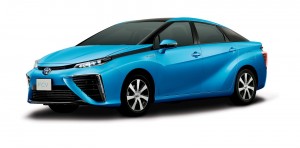Toyota announced its new fuel cell vehicle, the Mirai. Available only in California, it has a range of up to 300 miles at $57,500 (not including rebates and tax credits), which also includes free hydrogen fueling for three years. The advantage? It can refuel in 5 minutes, compared to an hour or way more in a traditional battery electric vehicle.
The disadvantages? Well, if you like looks and horsepower, this vehicle won’t do it for you. One website review called it “crazy ugly” and noted it takes 9 seconds to accelerate to 62 miles per hour (compared to 4.1 seconds for the Tesla Model S).
The real disadvantage? The fueling infrastructure isn’t there. While battery electric drivers may complain about the lack of charging stations, at least electricity is ubiquitous and basically cheap. But with hydrogen, we need a whole new, expensive, and energy-intensive infrastructure to produce and dispatch the hydrogen.
Here’s Toyota’s response:
Research at the University of California Irvine’s Advanced Power and Energy Program (APEP) has found that 68 stations, located at the proper sites, could handle a FCV population of at least 10,000 vehicles. Those stations are on their way to becoming a reality. By the end of 2015, 3 of California’s 9 active hydrogen stations and 17 newly-constructed stations are scheduled to be opened to the general public, with 28 additional stations set to come online by the end of 2016, bringing the near-term total to 48 stations.
Nineteen of those 48 stations will be built by FirstElement Fuels, supported by a $7.3 million loan from Toyota. The company has also announced additional efforts to develop infrastructure in the country’s Northeast region. In 2016, Air Liquide, in collaboration with Toyota, is targeting construction of 12 stations in five states – New York, New Jersey, Massachusetts, Connecticut, and Rhode Island.
Personally, I think the expense and energy needs for the fuel disqualifies hydrogen fuel cells as a viable technology, at least for passenger vehicles. However, given that we need to electrify pretty much all of our transportation to meet our long-term greenhouse gas reduction goals, I could see hydrogen being useful (and maybe necessary) for heavy-duty shipping, as batteries may not be able to provide the power necessary.
In any event, we can see how Toyota and other fuel cell-committed companies like Honda do with their technologies. But from a public policy standpoint, we should not be subsidizing the fueling infrastructure for vehicles like the Mirai.
Leave a Reply
You must be logged in to post a comment.



